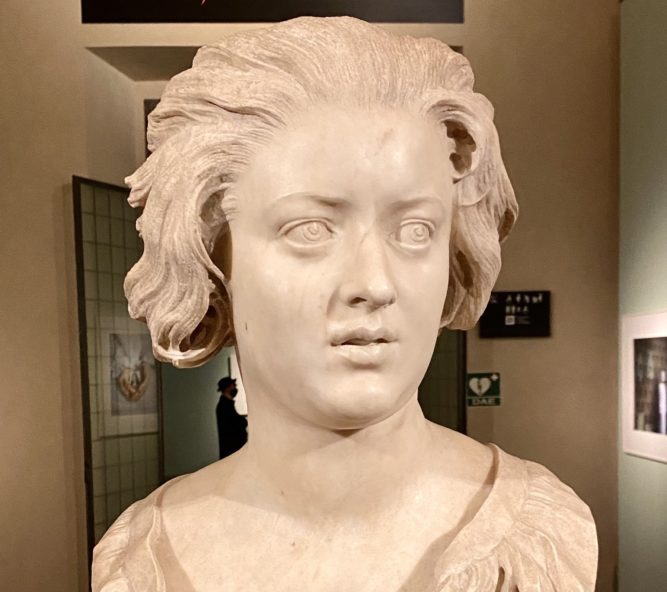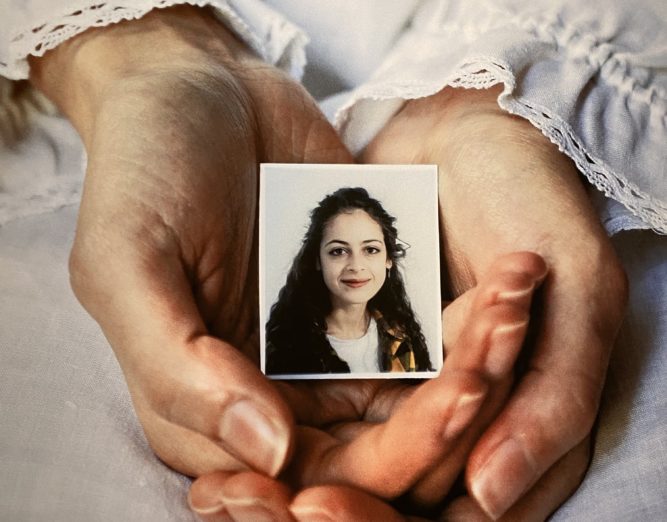‘Lo Sfregio,’ A Show Spotlighting Violence Against Women

Until December 19: LO SFREGIO (THE SCAR). Second floor, Uffizi Gallery. Open 8:15 am – 6:30 pm. Admission included in the €12 ticket to the Uffizi.
Photographs by Ilaria Sagaria from 2018 accompanied by a marble bust of Costanza Piccolomini from 1638 by Gian Lorenzo Bernini are currently on show at the Galleria degli Uffizi in an exhibition titled “Lo Sfregio” (“The Scar”). It tells a story of violence against women in a way that does not turn the victims’ pain into a spectacle, but rather one of documentation to bring awareness to these horrific events.
The bust that is on display in the first room of the exhibition shows a crime committed in 17th century Rome, where Costanza, Bernini’s lover, was discovered to be cheating on Bernini with his brother, Luigi. As a result, Bernini ordered someone to deface both Costanza, and the forehead and nose of her bust which he had originally sculpted her so enchantedly with beautiful, luminous skin and delicate features, with a scar (pictured). Bernini was put on trial, but was pardoned for his crime by Pope Urban VIII and did not even pay a fine for his actions. Costanza, on the other hand, was imprisoned in a monastery for four months as it was a crime for a woman to cheat in any way. After serving time, she then returned to her husband, Matteo Bonarelli, and began a successful trade in sculptures.
Today Costanza is recognized as a symbol of redemption and what that looks like when gender is taken into account. This, in turn, brings out the power of Sagaria’s photographs portraying victims of acid attacks, entitled Pain is Not a Privilege.

The photographs consist of different perspectives of women standing in a bedroom with gauze wrapped around their faces, with only a slight impression of their nose and eyes. The goal was to show the aftermath and pain of losing one’s identity from such brutal attacks without making the victims’ pain a sort of entertainment. Additionally, in the far room of the collection, there is a round mirror corroded with a similar acid used for the attacks sprayed on it so that the viewer can see what it is like to look at oneself after such a traumatic event. It is meant to evoke empathy in a way that is not just a mere personal reflection.
Acid attacks are a kind of widespread violence, usually done to women, in which the attacker sprays the victims’ faces with corrosive substances that burn through the skin and erode the bone, condemning the victims to not just physical pain, but a great deal of psychological trauma. The aim of the attacker is to rid any trace of beauty from the faces of their victims, causing those affected to suffer incredible pain. The victims can be blinded, can lose their hearing, and are essentially destroyed in all ways that make us human.
The psychological impact after these inhuman attacks consists of loss of identity, isolation to cope, and depression. Once hospitalized, many victims refuse to show their faces to others and even put photographs and mirrors away. They become stuck in a space lacking identity and memory of everything that they were/are, erasing their very life, much in the way their skin on their face was erased. Because acid costs so little and is so accessible, it makes it a common weapon and has become popular in developing countries with large areas of poverty like India, Bangladesh and Pakistan. The deepest wound of these actions is the fact that they lie in our society’s dismissive and discriminative perspective of women and their value that they hold in this world. (breanna assumma)
